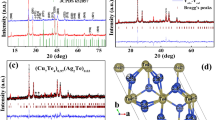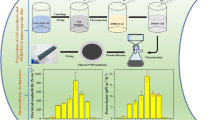Abstract
Ag-poly(3,4-ethylenedioxythiophene) (PEDOT) and Cu–PEDOT nanocomposites have been synthesized by an interfacial polymerization method, using 3,4-ethylenedioxythiophene (EDOT) and AgNO3 or Cu(NO3)2 as starting materials. Ag–PEDOT or Cu–PEDOT nanocomposites prepared at an interface of n-hexane and acetonitrile are spherical Ag- or Cu- nanoparticle (0D)-modified PEDOT nanostructures, while a Cu–PEDOT nanocomposite prepared at an interface of n-hexane and a mixture of acetonitrile and glycol exhibits a different morphology: Cu nanostructures are needle-like (1D) and embedded in a PEDOT matrix. Ag- or Cu-nanoparticle contents in the composites can be tuned by changing oxidant (AgNO3 or Cu(NO3)2)/EDOT molar ratios, and thermoelectric properties of the pellets cold pressed from composite powders with different Ag or Cu contents have been measured at room temperature. When the oxidant/EDOT molar ratio is 2, both Ag–PEDOT and Cu–PEDOT nanocomposites with spherical Cu nanoparticles reach their largest power factors of 1.49 and 7.07 μW m−1 K−2, respectively, while Cu–PEDOT nanocomposite with needle-like Cu nanoparticles has consistently higher power factor than the above composites. When the oxidant/EDOT molar ratio is 1, it reaches its largest power factor of 12.47 μW m−1 K−2 and the highest ZT value of 0.01 at room temperature.






Similar content being viewed by others
References
Balberg I (1985) Universal percolation-threshold limits in the continuum. Phys Rev B 31:4053
Balberg I, Anderson CH, Alexander S, Wagner N (1984) Excluded volume and its relation to the onset of percolation. Phys Rev B 30:3933
Boukai AI, Bunimovich Y, Tahir-Kheli J, Yu J-K, GoddardIII WA, Heath JR (2008) Silicon nanowires as efficient thermoelectric materials. Nature 451:168
Bubnova O, Khan ZU, Malti A, Braun S, Fahlman M, Berggren M, Crispin X (2011) Optimization of the thermoelectric figure of merit in the conducting polymer poly(3,4-ethylenedioxythiophene). Nat Mater 10:429
Cho MS, Kim SY, Nam JD, Lee Y (2008) Preparation of PEDOT/Cu composite film by in situ redox reaction between EDOT and copper(II) chloride. Synth Met 158:865
Du Y, Shen SZ, Cai KF, Casey PS (2012) Research progress on polymer-inorganic thermoelectric nanocomposite materials. Prog Polym Sci 37:820
Feng J, Ellis TW (2003) Feasibility study of conjugated polymer nano-composites for thermoelectrics. Synth Met 135:55
Girard SN, He J, Zhou X, Shoemaker D, Jaworski CM, Uher C, Dravid VP, Heremans JP, Kanatzidis MG (2011) High performance Na-doped PbTe-PbS thermoelectric materials: electronic density of states modification and shape-controlled nanostructures. J Am Chem Soc 133:16588
Groenendaal BL, Jonas F, Freitag D, Pielartzik H, Reynolds JR (2000) Poly(3,4-ethylenedioxythiophene) and its derivatives: past, present, and future. Adv Mater 12:481
Harish S, Mathiyarasu J, Phani KLN, Yegnaraman V (2008) PEDOT/Palladium composite material: synthesis, characterization and application to simultaneous determination of dopamine and uric acid. J Appl Electrochem 38:1583
Harman TC, Taylor PJ, Walsh MP, LaForge BE (2002) Quantum dot superlattice thermoelectric materials and devices. Science 297:2229
He M, Ge J, Lin Z, Feng X, Wang X, Lu H, Yanga Y, Qiu F (2012) Thermopower enhancement in conducting polymer nanocomposites via carrier energy scattering at the organic–inorganic semiconductor interface. Energy Environ Sci 5:8351
He M, Qiu F, Lin Z (2013) Towards high-performance polymer-based thermoelectric materials. Energy Environ Sci 6:1341
Hicks LD, Dresselhaus MS (1993) Effect of quantum-well structures on the thermoelectric figure of merit. Phys Rev B 47:12727
Hicks LD, Harman TC, Sun X, Dresselhaus MS (1996) Experimental study of the effect of quantum-well structures on the thermoelectric figure of merit. Phys Rev B 53:10493
Hochbaum AI, Chen R, Delgado RD, Liang W, Garnett EC, Najarian M, Majumdar A, Yang P (2008) Enhanced thermoelectric performance of rough silicon nanowires. Nature 451:163
Jiang FX, Xu JK, Lu BY, Xie Y, Huang RJ, Li LF (2008) Thermoelectric performance of poly(3,4-ethylenedioxythiophene): poly(styrenesulfonate). Chin Phys Lett 25:2202
Kaiser AB (2001) Electronic transport properties of conducting polymers and carbon nanotubes. Rep Prog Phys 64:1
Kim SY, Lee Y, Cho MS, Son Y, Chang JK (2007) Formation of gold nanoparticles during the vapor phase oxidative polymerization of EDOT using HAuCl4 oxidant. Mol Cryst Liq Cryst 472:591
Kim G-H, Shao L, Zhang K, Pipe KP (2013) Engineered doping of organic semiconductors for enhanced thermoelectric efficiency. Nat Mater 12:719
Koumoto K, Mori T (2013) Materials design and applications. Springer, Heidelberg
Kumar SS, Kumar CS, Mathiyarasu J, Phani KL (2007) Stabilized gold nanoparticles by reduction using 3,4-ethylenedioxythiophene-polystyrenesulfonate in aqueous solutions: nanocomposite formation, stability, and application in catalysis. Langmuir 23:3401
Li JJ, Tang XF, Li H, Yan YG, Zhang QJ (2010) Synthesis and thermoelectric properties of hydrochloric acid-doped polyaniline. Synth Met 160:1153
Mateeva N, Niculescu H, Schlenoff J, Testardi LR (1998) Correlation of Seebeck coefficient and electric conductivity in polyaniline and polypyrrole. J Appl Phys 83:3111
Mori T, Nishimura T, Yamaura K, Takayama-Muromachi E (2007) High temperature thermoelectric properties of a homologous series of n-type boron icosahedra compounds: a possible counterpart to p-type boron carbide. J Appl Phys 101:093714
Park T, Park C, Kim B, Shin H, Kim E (2013) Flexible PEDOT electrodes with large thermoelectric power factors to generate electricity by the touch of fingertips. Energy Environ Sci 6:788
Patra S, Munichandraiah N (2009) Electrooxidation of methanol on pt-modified conductive polymer PEDOT. Langmuir 25:1732
Pei Y, Shi X, LaLonde A, Wang H, Chen L, Snyder GJ (2011) Convergence of electronic bands for high performance bulk thermoelectrics. Nature 473:66
Poudel B, Hao Q, Ma Y, Lan YC, Minnich A, Yu B, Yan X, Wang DZ, Mouto A, Vashaee D, Chen XY, Liu JM, Dresselhaus MS, Chen G, Ren ZF (2008) High-thermoelectric performance of nanostructured bismuth antimony telluride bulk alloys. Science 320:634
Rowe DM (1995) CRC handbook of thermoelectrics. CRC, Boca Raton
Shirakawa H, Louis EJ, MacDiarmid AG, Chiang CK, Heeger AJ (1977) Synthesis of electrically conducting organic polymers: halogen derivatives of polyacetylene, (CH)x. J Chem Soc Chem Commun 474:578
Skotheim TA, Reynolds JR (1986) Handbook of conducting polymers. Dekker, New York
Sun J, Yeh ML, Jung BJ, Zhang B, Feser J, Majumdar A, Katz HE (2010) Simultaneous increase in seebeck coefficient and conductivity in a doped poly(alkylthiophene) blend with defined density of states. Macromolecules 43:2897
Toshima N (2002) Conductive polymers as a new type of thermoelectric material. Macromol Symp 186:81
Venkatasubramanian R, Siivola E, Colpitts T, O’Quinn B (2001) Thin-film thermoelectric devices with high room-temperature figures of merit. Nature 413:597
Wang YY, Cai KF, Yao X (2011a) Facile fabrication and thermoelectric properties of PbTe-modified poly(3,4-ethylenedioxythiophene) nanotubes. ACS Appl Mater Interfaces 3:1163
Wang YY, Cai KF, Yin JL, An BJ, Du Y, Yao X (2011b) In situ fabrication and thermoelectric properties of PbTe-polyaniline composite nanostructures. J Nanopart Res 13:533
Xie WH, Tang XF, Yan YG, Zhang QJ, Tritt TM (2009) High thermoelectric performance BiSbTe alloy with unique low-dimensional structure. J Appl Phys 105:113713
Acknowledgments
This work was supported by the 973 Project under Grant No. 2013CB632500, National Natural Science Foundation of China (51271133, 61306018), the Doctoral Program of Higher Education of China, State Key Lab of Advanced Technology for Materials Synthesis and Processing (Wuhan University of Technology), and State Key Lab of Silicon Materials (Zhejiang University).
Author information
Authors and Affiliations
Corresponding author
Electronic supplementary material
Below is the link to the electronic supplementary material.
Rights and permissions
About this article
Cite this article
Wang, Y., Cai, K., Chen, S. et al. One-step interfacial synthesis and thermoelectric properties of Ag/Cu-poly(3,4-ethylenedioxythiophene) nanostructured composites. J Nanopart Res 16, 2531 (2014). https://doi.org/10.1007/s11051-014-2531-y
Received:
Accepted:
Published:
DOI: https://doi.org/10.1007/s11051-014-2531-y




